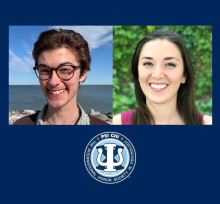
Assistant Professor of Biology and Neuroscience Sarah Latchney recently published a new research article in the Journal of Neuroimmunology, co-authored with undergraduate students Anjali Raheja ’26 and Brayan Ruiz Lopez ’24. The paper, titled “Glial changes in the dentate gyrus of neuronal-specific PTEN knockout mice correlate with changes in cell proliferation,” explores how changes in neuron production and glial activity might be linked to seizures and epilepsy.
This study builds on earlier work by Latchney and Ruiz Lopez, which investigated how removing a signaling molecule called Pten (phosphatase and tensin homolog deleted on chromosome 10) affects the production of new neurons in the adult brain, a process known as neurogenesis. Ruiz Lopez’s initial work found that mice missing Pten display atypical increases in neuron production in the adult hippocampus, including areas not typically known to generate new neurons.
With the support of a 2024 Seahawk Undergraduate Research Fellowship (SURF) and a Flores research award through the Biology Department, Raheja continued this research to test whether the increased neuron production coincided with an increase in non-neuronal cells called glia.
“I first started learning the background and lab skills during my sophomore year under Dr. Latchney and Brayan’s mentorship,” Raheja explained, “During SURF 2024, I performed immunohistochemistry and cell quantification in mouse brains. This work helped us learn more about the type and amount of cell growth that occurs as a result of knocking out the tumor suppressor gene Pten.” Her findings revealed that where Ruiz Lopez observed increased neurogenesis, there were also more microglia and astrocytes, two key types of glial cells.
These new findings suggest a potential connection between abnormal neuron production and glial activity in a brain region that is susceptible to seizures. Since mice missing Pten are prone to developing seizures, the research points to a possible role for glial cells in the pathophysiology of seizure activity and epilepsy.
When reflecting on her experiences, Raheja noted the support and opportunities she received: “Dr. Latchney is very supportive and a great teacher. I’ve learned a lot about glial activity, lab techniques, data analysis, and other research skills under her. She has also supported me in going to the Society for Neuroscience conference to present our research, which was an amazing experience. This project and publication have encouraged me to go to graduate school and pursue a career in research.”



